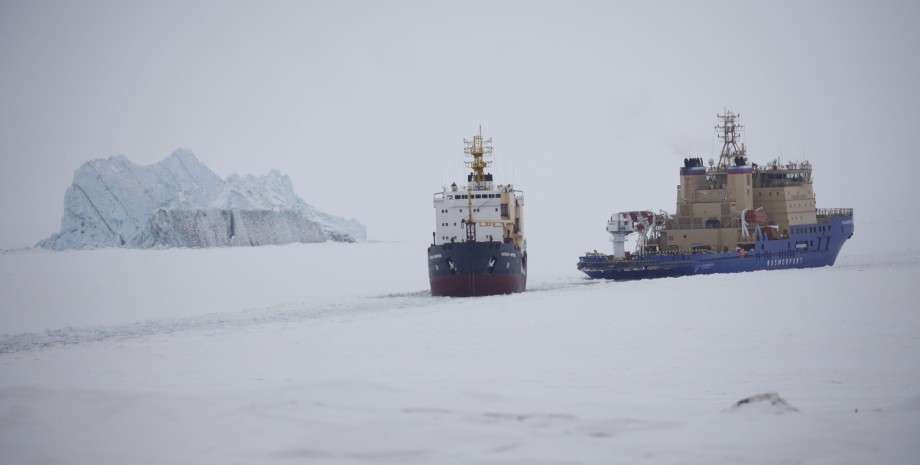
 By Victor Duda
By Victor Duda
The Arctic is an international neutral zone governed by the Arctic Council-the main cooperation authority between eight countries. The meeting of the Council has been terminated since last year, as Russia, which has been presiding until May 11, has been isolated due to aggression against Ukraine.
Although no one "possesses" the North Pole, the countries whose lands surround the central part of the Arctic Ocean already have the rights that go far beyond their coastline in accordance with international law. Each of them already has a jurisdiction over an exceptional economic zone that does not reach the central part of the Arctic Ocean.
Now Russia, Canada and Denmark on behalf of its autonomous dependent territory of Greenland are defending the wider sovereign rights to the huge strip of the Arctic seabed that stretches through the North Pole. Lomonosov's spine extends from Canada and Greenland to Siberia, so Russia, Denmark and Canada claim that it is a continuation of their continental shelf.
According to the UN Convention on the Law of the Law, it will give exceptional sovereign rights to natural resources on the polar day and below, beyond exceptional economic zones. Meanwhile, the United States did not ratify the UN Convention, but may be preparing their own statement, the publication writes.
"The United States has been collecting data in the Arctic for decades, and we constantly hear the claims," said Rebecca Pinkus, director of the Polar Institute at the Wilson Center, Washington Analytical Center. In the end, the United States will start a fight, it considers, at least in order to control how at least some resources are used.
Like these countries, Norway has applied, supported in 2009 by an independent body, which was instructed to consider a science known as the Commission from the borders of the continental shelf (CLCS), but it stops far from the North Pole. Obtaining access to potentially profitable resources is one of the main reasons why countries apply. It is believed that the Arctic seabed contains large reserves of fossil fuels, metals and the most important minerals.
According to the latest assessment of the US geological service, which was conducted in 2008, there are about 90 billion barrels of unrecognized oil and more than 47 trillions of cubic meters of gas, as well as the important metals and minerals needed for electrification.
Russia, which has been engaged in the production of oil on the shelf of the Arctic, has pledged to increase production on land and sea by 2035 in its Arctic strategy, although its most ambitious plans have been postponed because of sanctions, Bloomberg notes. The extraction of fossil fuels and deep -sea mining in the world that is crucial for the planet's climate protection, is heavy controversy. But obtaining sovereign rights to offshore resources can be both protected and operated.
"If you have the right to the seabed, you also have the right to declare that the development of these resources is forbidden," says Mark Jacobsen, Associate Professor of the Danish Royal Defense College. " environment". Back in 2007, when Putin approached the completion of his second presidential term, Russia put a flag on the seabed on the North Pole to declare its symbolic, although not supported by law claims to the top of the planet, reminiscent of the publication.
In February, the CLCS determined that much of the data presented by Russia is confirmed by geological data, although other parts require additional maps and research. In the same month, Russia responded with explanations.
If the CLCS agrees with this, the continental shelf of Russia in the central part of the Arctic Ocean, it will probably consist of 516,400 square sea miles (684,000 square miles) - an area exceeding Libya, according to the analysis of the Darm Doma Department of International Border Research. "This means that Russia is the only one of the three countries with victory claims that at least partially coincide. But that does not mean that Denmark and Canada are not lucky.
In the end, the CLCS can determine that Lomonosov's spine is part of the general continental shelf, which means that everyone will have to share. In the end, countries may need to reconcile borders with each other or through a stranger, the publication writes. Changes in the latest Arctic Strategy of Russia, set out in the foreign policy document signed by Putin on March 31, exclude references to "constructive international cooperation".
The document states that Russia should repel the unfriendly states who hope to militarize the region and establish closer relations of cooperation with non -arctic states that "pursue constructive policy on Russia", possibly in mind China, notes the publication. On April 4, Finland became a member of NATO, if it is joined by Sweden, then Russia will become the only Arctic state that is not a member of the Alliance.
We will remind, on April 24 the media reported that Russia continues to strengthen its "northern borders" and launched another complex of radio -electronic struggle (EIT) in the Arctic region. By the end of the year, the Arctic plan to install 5 resonance complexes that can intercept hypersonic missiles having a speed of 20 strokes (24 500 km/h).










All rights reserved IN-Ukraine.info - 2022